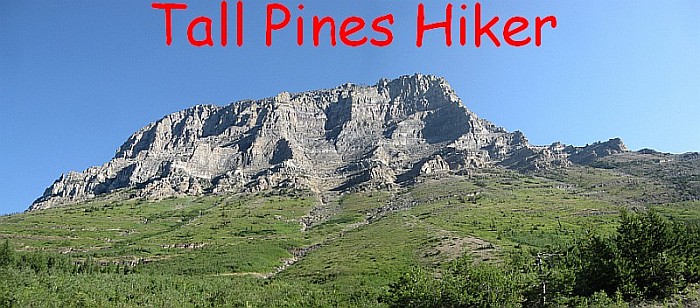Distance roundtrip: I estimate 4 to 4.5 miles
Elevation gain: from the topo map I estimate 800 or a bit more feet.
Lookout elevation: 6051 ft
We again followed the directions in Kendra's copy of the Fire Lookouts in NW Montana book. The route description and some photos are the same as I found later on the following summitpost web page:
http://www.summitpost.org/davis-mountain/727113
But... when we reached Forest Service 3532 it was gated shut. What?! (This route is marked in purple in the map below.)
Not only one lock fastened the gate, but two locks. We were locked out.
We didn't have a map so we couldn't look if an alternate route existed. Time for plan B. As we drove to the plan B lookout we passed the Murphy Lake Ranger Station. We stopped in.
We learned FS road 3532 (like the other roads marked in yellow) was closed each year from July 1 to December 1. When did the book and summitpost author(s) hike to the lookout? June 29. No mention that the road could be closed.
Alternatives?
- Trail #212. This trail originates at the end of FS Road #7156 just south of Swamp Mountain. It would be very possible to combine Davis Mountain with Swamp Mountain. The trail is 6.5 miles to Davis Mountain. 13 miles RT - too far for Kendra to hike while she is undergoing radiation treatment.
- Trail #279 (Warland Ridge trail) which approaches from the southwest. Approximately 2 miles long (one-way). To get to this TH, drive 17.2 miles on #36, then turn right on FS Road #835. Drive 3.56 miles on #835 to #4424. Turn right on #4424 and drive 3 miles to the TH on the right side of the road. You can also access Warland Peak to the west via this trail...on the left side of the road.
Again the gravel forest service roads were in very good condition. On the map above our driving route is in red. Trail 279 is marked in blue.
 |
| Aerial view |
At mile 3 on FS 4424...
is the start of the trail.
Don't worry. There is an easy place to park your vehicle off road near the trail.
At times the trail could be easily seen as a path through the grass. Other times the trail was marked by lots of rock cairns. The trail was easy to follow with little second guessing as to where the trail was located. We only encountered three or four trees down across the trail. It was easy to walk around them.
After the first little climb I looked to the NW and think I saw the McGuire, Little Sutton and Sutton peaks where we had hiked last week.
A short distance later we could see the fire tower barely above/among the trees. What we didn't know is that the trail did not take the shortest distance from point A to B, even though it looked that way on the map (I added the little 'hook' on the end when I marked the trail in blue on the earlier map).
From the lower red X we hiked down a hundred to two hundred feet, then hiked up along the side of Davis Mountain to about the red X on the right. Then we hiked the fat spine of Davis Mountain to the lookout. This is why I think the trail is a little over 2 miles long, though on the map the trail goes fairly straight and appears to be no more than 2 miles.
The topography is not that steep so I don't know why a trail wasn't created in the shortest distance possible, unless they wanted the longest shallowest switchback on record. It is a good thing we saw the lookout at this point, else when we walked among the tall trees along the spine we would have questioned if we were on the right trail. As it was, the walk along the spine was long enough we wondered if we would ever get to the lookout. And once we were on the spine we lost the views of the valleys until just before reaching the tower.
The present 60' steel tower with 7x7' cab and ladder, along with the accompanying log cabin, were built about 1931, and have been abandoned for several years.
The cabin was pretty cool. Kendra would like to live here. The log walls were in good shape even if the rest of the cabin was not. The three trees next to the front porch must have been 'planted' by birds. More photos of the cabin, and the outhouse with no view, are at the link at the end.The tower's ladder was removed from the bottom two sections of the tower (about 12 ft).
I rattled the tower's "x" on one side and the metal wobbled more than I expected. Another reason not to try to shimmy up the tower to the ladder.
This tower reminds me of my friend Jeff. He bought an old fire tower in northern MN and then erected it on his property. His tower is similar, and may be almost as tall, though his cab on top may be smaller.
For more photos, follow this link:
https://plus.google.com/photos/109566462412251958234/albums/6065132053819826705?authkey=COuzqMXa1sWucg
-












































